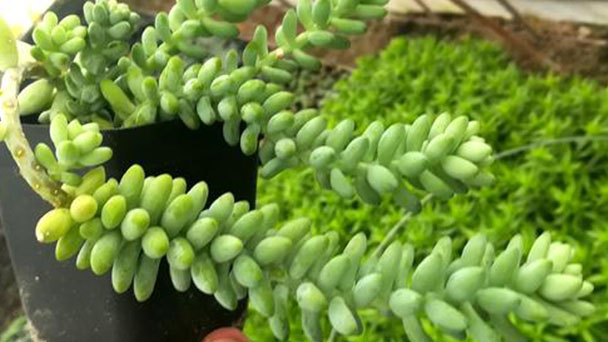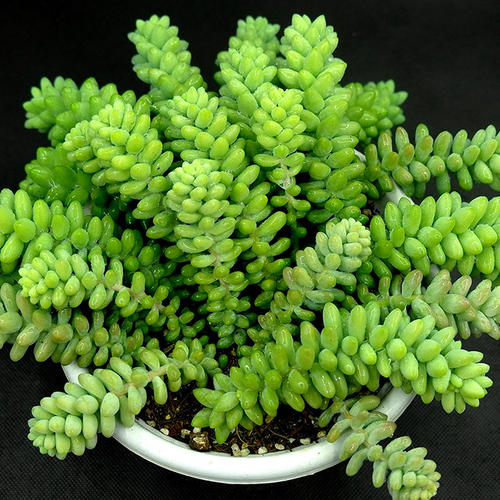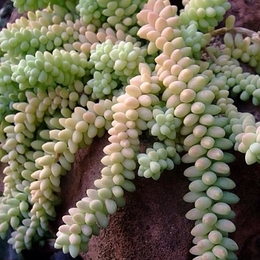How to Grow and Care for Burros Tail
Written by Maggie
Dec 09 2022

Sedum morganianum, also known as the burro's tail, will be fully discussed in this guide, along with its propagation and maintenance requirements for both indoor and outdoor succulent gardens, so keep reading to learn more.
In order to grow and care for Burro's Tail (Sedum morganianum) well, it is necessary to be familiar with the lighting, watering and fertilization requirements of Burro's Tail in different seasons.
Appropriate Temperature Care for Growing Burro's Tail
The first thing to know is that Burro's Tail grows at 18 ~ 25 ° C, so the ambient temperature needs to be controlled within this range.
When we grow and care for Burro's Tail in summer, the temperature is relatively high, so the environment needs to be strengthened to cool and ventilate. If the summer temperature exceeds 35℃, the Burro's Tail will go into hibernation. Burro's Tail can grow normally if the winter temperature is above 10 ° C,
If the temperature is lower than 5℃, be sure to keep the basin soil dry, otherwise it is easy to frostbite.
Basin Soil Care for Growing Burro's Tail
Burro's Tail plants are made with loose, fertile, sandy soil that drains well. When we grow and care for Burro's Tail, potted soil can be made from a mixture of garden soil, coarse sand, vermiculite, and a small amount of bone meal or chicken manure can also be added to the soil as a base fertilizer for the growth of Burro's Tail.
Light Care for Growing Burro's Tail
Burro's Tail likes plenty of light. The larger the temperature difference between day and night, the brighter the color of its leaves, and they need to be kept under full daylight in spring and autumn.
It is hot in summer and the temperature is high. When we grow and care for Burro's Tail, we need shade to avoid the strong sunlight in summer. It is suggested to move Burro's Tail potted plants to a ventilated and cool place for maintenance.
In winter, it is recommended to keep Burro's Tail in a sunny place and not in a hot place.
Watering Care for Growing Burro's Tail
We can grow Burro's Tail in spring and fall, during which it needs to be watered every two to three days. Summer temperature is high, it is to spray water around the plant generally, increase the humidity of the environment, and can be watered 1-2 times a month. In the fall, the temperature is also falling. When we grow and care for Burro's Tail, we can slowly reduce the amount of watering. Once the Burro's Tail grows very slowly in winter, it can be cut off or not watered.
You shouldn't need to water Burro's Tail more frequently than once every two weeks if you're giving your plant the right amount of light. Before giving the soil a good watering, let it completely dry out. If you have a cutting, a very young plant, or a plant in a two-inch pot, you would be the only person who could break this rule. Then you should water more frequently, but in smaller amounts.
Concerned about both overwatering Burro's Tail and underwatering Burro's Tail at the same time? Succulents are equipped with an internal warning system that lets you know when they require water, so don't worry. It's time to water your plant if you see that the usually hefty leaves have begun to pucker, resembling the outside of a raisin. The plant's leaves will rehydrate after being watered!

Fertilization Care for Growing Burro's Tail
Burro's Tail is usually used up when it blossoms, so you need to supplement it to make sure it grows properly. When we grow and care for Burro's Tail, it is recommended that you give the Burro's Tail some decrepit organic fertilizer.
Growing Burro's Tail Care in Summer
Burro's Tail grows slowly or stops growing in the summer. When we grow and care for Burro's Tail, just keep the environment well-ventilated and avoid strong sunlight to avoid Burro's Tail shriveling. Also, in the rainy summer, avoid getting wet and causing rot.
Growing Burro's Tail Care in Winter
In winter, flower friends are advised to move the Burro's Tail indoors for maintenance. If the ambient temperature is below 5℃, then stop watering and fertilizing. When we grow and care for Burro's Tail, don't spray water in winter, because if you spray water to the leaves, the water will stay in the leaves for a long time, which will cause the leaves to rot, so water directly on the roots of the Burro's Tail.

Burro's Tail Propagation Guide
It's very similar to propagating most other succulents that are similar to burro's tail. Using individual leaves or cuttings are the two methods for propagating burro's tail succulents.
A few individual leaves are visible in the soil in the image below. I chose to leave the leaves that fell off when I repotted the plant in the pot so they could continue to grow. Then, you can see that the young plants have already sprouted and have their own roots! I'm hoping they'll take root and essentially merge with the main plant.
Stem cuttings are yet another method of propagating a burro's tail succulent plant. Because you have to cut a piece of the stem that is several inches long, this procedure makes my heart hurt a little. Since I haven't yet done that, it is obvious. You'll need to cut the piece, remove the leaves from the bottom inch or so, and then let all of the "wounds" callus over before planting.
You can now place the stem in a tiny pot with succulent soil for planting. To promote the development of new roots, keep the planted cutting just barely moist. Soon enough, it will take root and start expanding rapidly.
How to Repot Burro's Tail
Repotting a donkey's tail can be challenging because of its delicate stems and foliage, in contrast to their more manageable propagation. Its foliage is very prone to drooping, and handling and repotting may cause it to lose a lot of leaves. Your burro's tail plant's roots will outgrow the container, though, if they get too big. Then, carefully repot your succulent in a terracotta container with drainage holes and quick-draining soil.When the soil around the plant is dry, carefully remove it from the container and inspect it for root rots. Eliminate the decaying and ungroomed roots. Fresh cactus soil and pumice mix should be added to the larger-sized container. To plant the burro's tail, create a hole in the center of the growth medium, place it there, and then backfill the area to conceal the roots.
After repotting, place the plant in bright light and give it a week to rest before watering it.
Common Burro's Tail Diseases
Root Rot
Your succulent houseplants will get the monster (root rot) if you overwater them and there is poor drainage. Due to a deficiency in nutrients and strong roots, root rot causes the entire healthy plant to turn brown, mushy, and black.The best way to keep your plant from getting sick is to remove only the healthy stem tips and leaves for propagation. It is difficult to revive the severely damaged and nearly wilted plants, so it is best to discard the remaining plants. However, if you're fortunate enough to spot the root decay at an early stage, uproot the plant right away, remove the rotten roots, and repot it in new potting soil.
Common Burro's Tail Pests
For the majority of their life cycle, burro's tail plants are pest-free, but in the early spring, they may experience infestations of mealybugs and aphids.Mealybugs
The burro's tail plant's juicy leaves, which have a lot of new growth, are what draw the sap-eating insects in the first place. Mealybugs hide in the plant's folds and infest the young leaves, feeding on the nutrients and going unnoticed because they are concealed. Since there are so many of them, the burro's plant may become defoliated and eventually die.Keep an eye on your succulent plant and use sprays of rubbing alcohol, insecticidal soap, and neem oil to remove any tiny bugs you spot on the underside of the leaves.
Aphids
Your succulent plant is infested by these tiny, pear-shaped insects, which drain the nutrients from its leaves. While feeding, aphids also excrete sugary substances (honeydew) on the infected leaves.Ants and the fungus black sooty mold are thus attracted, leading to secondary pest infestations.
To keep aphids and their nymphs away, use sprays of horticultural oil, insecticidal soap, and neem oil. In order to pierce the soft bodies of adult, wingless aphids, scatter diatomaceous earth around the base of the plant.
FAQs on Burro's Tail
How Fast Do Burro's Tail Grow?
A slow-growing herbaceous perennial, burro's tail grows to a mature height of 4 feet in six years. However, in ideal growing environments both indoors and outdoors, this succulent survives for many years.What's the Difference Between a Donkey's Tail and a Burro's Tail?
The donkey's tail is the dwarf version of the original burro's tail (Sedum morganianum) with small, rounded, and blue-green leaves. In contrast, the burro's tail has angular, grey-green or pale green leaves that resemble rice grains. The baby donkey's tail is more suited to limited space than the Sedum morganianum, which is perfect for spacious areas. (Also Read: Burros Tail VS Donkey Tail)Burro's Tail Temperature Tolerance?
This succulent plant grows best in temperatures of 65 to 75 degrees Fahrenheit, but it can survive in as low as 40 ºF. When nighttime lows regularly fall below 40 ºF, bring your plant inside to avoid freezing damage.How Do You Get Burro's Tail to Flower?
Although it rarely blooms indoors, this succulent plant can be grown outdoors and will then produce tiny, star-shaped flowers. Allow your burro's tail plant to spend the summer outdoors at 75 degrees Fahrenheit and then move them indoors in the cool winters with cool temperatures between 50 ºF and 60 ºF to promote blooming. The donkey's tail will begin to flower due to this mild temperature stress. (Also Read: How Do I Make My Burros Tail Bloom?)Is Epsom Salt Good for Succulents?
Because it contains magnesium, sulfur, and oxygen, Epsom salt is used as food for succulents and helps them grow lush green foliage and beautiful flowers.
What is Burro's Tail Used For?
Burro's tail works well in a hanging basket and decorates a mixed cactus and succulent container. It makes a unique ground cover and thrives in rockery cracks. Consider putting the bushy stems in a bed of vibrant perennials or seasonal flowers.Is Burro's Tail Toxic?
Their leaves will become soft and wrinkled if they are thirsty, which is a sign. All things considered, donkey's tail and burro's tail are attractive and entertaining plants that liven up any house or garden. As a bonus for those of you with pets or young children, they're not toxic to humans or animals.
Latest Updated
- Benefits of Bugleweed - 7 Science-backed Health Benefits
- Bugleweed Dangers & Side Effects - Is It Poisonous?
- How to Plant Evergreen Trees - What You Should Know
- When to Plant Evergreens - Grow Guide for Evergreen Trees
- 12 Wonderful Evergreen Shrubs for Your Garden
- 12 Popular Evergreen Plants with Pictures for Beginners
- When And How To Prune A Lilac Bush Like a Pro
- How to Grow & Care for Lilac Vine (Hardenbergia Violacea)
- Japanese Lilac Tree (Syringa Reticulata) Care & Propagation Guide
- Shumard Oak Pros and Cons - What to Know
Popular Articles
- Winter maintenance of Antirrhinum Majus
- How to Grow Terminalia Mantaly Tree
- How to Grow and Care for Crossostephium Chinense
- How to grow Antirrhinum Majus in spring
- Peristeria Elata (Dove Orchid) Profile: Info & Care Guide
- Underwatered Snake Plant (Sansevieria Trifasciata) - Signs And How To Fix
- How to Care for Brazilian Jasmine Plant (Mandevilla Sanderi)
- How to Grow & Care for Graptopetalum Purple Delight in Summer
- Rosa Chinensis (China Rose): Plant Growing & Care Tips
- How to Care for Baby Sun Rose (Aptenia Cordifolia)